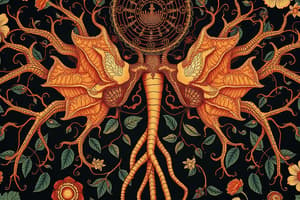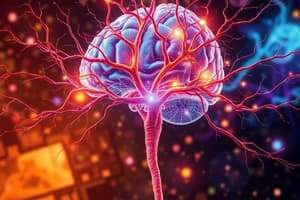Podcast
Questions and Answers
What is the primary function of the sympathetic nervous system?
What is the primary function of the sympathetic nervous system?
- To manage involuntary physiologic processes
- To facilitate rest and digestion
- To regulate voluntary control of muscles
- To initiate fight or flight responses (correct)
Which type of neuron has one axon and one dendrite?
Which type of neuron has one axon and one dendrite?
- Interneurons
- Unipolar neurons
- Bipolar neurons (correct)
- Multipolar neurons
What is the role of oligodendrocytes in the central nervous system?
What is the role of oligodendrocytes in the central nervous system?
- To become scar tissue
- To produce myelin sheath (correct)
- To maintain the blood-brain barrier
- To create neurotransmitters
Where are neurotransmitters primarily synthesized in neurons?
Where are neurotransmitters primarily synthesized in neurons?
What does the term 'myenteric plexus' refer to?
What does the term 'myenteric plexus' refer to?
Which part of the nervous system is primarily responsible for voluntary control?
Which part of the nervous system is primarily responsible for voluntary control?
Which type of glial cell forms scar tissue in the CNS?
Which type of glial cell forms scar tissue in the CNS?
What are the structures called that protect the brain?
What are the structures called that protect the brain?
Which structure is NOT a component of the central nervous system?
Which structure is NOT a component of the central nervous system?
What is the role of the preganglionic neuron in the autonomic nervous system?
What is the role of the preganglionic neuron in the autonomic nervous system?
In the context of the sympathetic nervous system, what does inhibition of bladder contraction imply?
In the context of the sympathetic nervous system, what does inhibition of bladder contraction imply?
What is the primary composition of the myelin sheath in axons?
What is the primary composition of the myelin sheath in axons?
Which type of neuron is primarily responsible for transmitting sensory information from the periphery to the central nervous system?
Which type of neuron is primarily responsible for transmitting sensory information from the periphery to the central nervous system?
What physiological process does the enteric nervous system primarily control?
What physiological process does the enteric nervous system primarily control?
Which characteristic is unique to multipolar neurons compared to other neuron types?
Which characteristic is unique to multipolar neurons compared to other neuron types?
What type of glial cell is primarily responsible for maintaining the blood-brain barrier?
What type of glial cell is primarily responsible for maintaining the blood-brain barrier?
During nerve transmission, what is the path followed by sensory input?
During nerve transmission, what is the path followed by sensory input?
Which component does NOT form part of the protective coverings of the brain?
Which component does NOT form part of the protective coverings of the brain?
Study Notes
Nervous Tissue
-
The nervous system is responsible for responding to changes in the external and internal environment.
-
The central nervous system (CNS) consists of the brain and spinal cord, protected by the skull and vertebral column, meninges (dense irregular connective tissue), and cerebrospinal fluid (CSF).
-
The peripheral nervous system (PNS) consists of nerves outside the CNS, including cranial and spinal nerves, as well as ganglia.
Functional Divisions
- The somatic nervous system regulates voluntary control of skeletal muscle, with one somatic neuron per muscle.
- The autonomic nervous system controls involuntary physiological processes, involving two shorter neurons: a preganglionic neuron and a postganglionic neuron.
Autonomic Divisions
-
Sympathetic nervous system:
- Dilates pupils and bronchi.
- Converts glycogen to glucose.
- Releases adrenaline.
- Inhibits bladder contraction and peristalsis.
- Known as the "fight or flight" response.
- Uses acetylcholine in the shorter preganglionic neuron and norepinephrine in the postganglionic neuron.
-
Parasympathetic nervous system:
- Promotes "rest and digest" functions.
- Uses acetylcholine in both the longer preganglionic neuron and shorter postganglionic neuron.
-
Enteric nervous system:
- Located within the walls of the gastrointestinal tract, and contracts segmentally.
- Functions independently of the CNS and autonomic nervous system.
- Comprises four layers: mucosa, submucosa, muscularis, and serosa.
- Nerves in the muscularis are called the Myenteric or Auerbach's plexus, controlling contraction.
- Nerves in the submucosa are known as the Meissner's plexus, responsible for glandular secretions.
- Modulated by the autonomic nervous system.
Neurons
- Neurons are the functional units of the nervous system.
- The soma (cell body) contains the nucleus.
- The axon is covered by a myelin sheath.
- CNS neurons are more angular, with many rough endoplasmic reticulum (RER) or Nissl bodies (chromatophilic substance) for making neurotransmitters.
Neuron Structures
-
Group of cell bodies:
- Nucleus in the CNS
- Ganglia in the PNS
-
Dendrites:
- Carry impulses toward the cell body.
- Are darker than axons.
-
Axons:
- Carry impulses away from the cell body.
- Are covered by a myelin sheath (composed of lipids).
-
Axon hillock:
- The area where the axon joins the cell body.
- Lacks organelles.
Nerve Transmission
- Afferent or sensory input: Carries information from the PNS to the CNS.
- Efferent or motor output: Carries information from the CNS to the PNS.
Gray and White Matter
-
Gray Matter:
- H-shaped.
- Contains dendrites and cell bodies.
-
White Matter:
- Contains axons.
Neuron Pathway
- Sensory neurons travel from the dorsal root to the posterior horn and then to the white matter.
- Signals from white matter travel to the anterior gray horn and then to the ventral root.
Types of Neurons
-
Morphology:
- Multipolar neurons: Have multiple dendrites and one axon. Most common.
- Bipolar neurons: Have one axon and one dendrite. Found in the retina.
- Unipolar neurons: Have an axon and dendrite connected by a common stalk. Found in spinal and dorsal root ganglia.
-
Posterior gray horns: Contain interneurons for reflex actions.
CNS Neuroglia
-
Astrocytes:
- Maintain the blood-brain barrier.
- Absorb excess neurotransmitters.
- Protect against oxidative stress.
- Form scar tissue.
- Contain glial fibrillary acidic protein (GFAP).
-
Oligodendrocytes:
- Produce myelin sheath in the CNS.
Nervous Tissue
- Neural tissue is responsible for communication within the body.
Nervous System
- Responds to changes in the external and internal environment.
- Composed of the central nervous system (CNS) and peripheral nervous system (PNS).
Central Nervous System (CNS)
- Consists of the brain and spinal cord.
- Protected by the skull and vertebral column.
- Covered by meninges, which are dense irregular connective tissues.
- Filled with cerebrospinal fluid (CSF).
Protective Coverings of the Brain
- Skull: the bony structure protecting the brain.
- Meninges: three layers of connective tissue surrounding the brain and spinal cord.
Peripheral Nervous System (PNS)
- Consists of peripheral nerves, ganglia (clusters of neuron cell bodies), cranial nerves, and spinal nerves.
- Cranial nerves are located outside the protection of the skull and vertebral column.
Functional Divisions of the Nervous System
Somatic Nervous System
- Controls voluntary muscle movements.
- One somatic neuron connects to each skeletal muscle.
- Uses acetylcholine as a neurotransmitter.
Autonomic Nervous System
- Controls involuntary physiological processes.
- Composed of two shorter neurons: preganglionic and postganglionic neurons.
- Further divided into sympathetic and parasympathetic systems.
Sympathetic Nervous System
- "Fight or flight" response.
- Dilates pupils and bronchi.
- Converts glycogen to glucose.
- Releases adrenaline.
- Inhibits bladder contraction and peristalsis.
- Uses acetylcholine as its preganglionic neurotransmitter and norepinephrine as its postganglionic neurotransmitter.
Parasympathetic Nervous System
- "Rest and digest" response.
- Uses acetylcholine as its preganglionic and postganglionic neurotransmitter.
Enteric Nervous System
- Located within the walls of the gastrointestinal tract.
- Controls segmental contractions of the digestive tract.
- Functions independently of the CNS and autonomic nervous system.
- Consists of four layers: mucosa, submucosa, muscularis, and serosa.
- Nerves in the muscularis layer are called the myenteric or Auerbach's plexus and control contractions.
- Nerves in the submucosa layer are called the Meissner's plexus and control gland secretions.
- Modulated by the autonomic nervous system.
Neurons
- The functional unit of the nervous system.
- Consists of a soma (cell body) containing the nucleus, an axon (conducts nerve impulse), and dendrites (receive nerve impulses).
- Axons are typically covered by a myelin sheath made of lipids.
- CNS neurons are more angular in shape and have many RER (rough endoplasmic reticulum) or Nissl bodies (chromatophilic substance) for making neurotransmitters.
- Groups of cell bodies are called nuclei in the CNS and ganglia in the PNS.
Dendrites
- Receive nerve impulses and carry them towards the cell body.
- Appear darker than axons due to the presence of ribosomes.
Axons
- Carry nerve impulses away from the cell body.
- Covered by a myelin sheath composed of lipids.
Axon Hillock
- The region where the axon connects to the cell body.
- Lacks organelles.
Nerve Transmission
- Nerve transmission involves the movement of nerve impulses.
- Afferent (sensory) neurons carry impulses from the PNS to the CNS.
- Efferent (motor) neurons carry impulses from the CNS to the PNS.
Gray Matter
- Contains dendrites, cell bodies, and unmyelinated axons.
- Has a "H" shape in the spinal cord.
White Matter
- Consists of myelinated axons.
Sensory Neuron Pathway
- Sensory neurons travel from the dorsal root to the posterior horn of the spinal cord and then to the white matter.
Motor Neuron Pathway
- Motor neurons travel from the white matter to the anterior gray horn and then to the ventral root.
Types of Neurons Based on Morphology
Multipolar Neurons
- Have multiple dendrites and one axon.
- Carry motor impulses.
- The most common type of neuron.
Bipolar Neurons
- Have one axon and one dendrite.
- Found in the sensory retina.
Unipolar Neurons
- Have a single process that branches into an axon and a dendrite.
- Found in spinal and dorsal root ganglia.
Interneurons
- Located in the posterior gray horn of the spinal cord.
- Facilitate reflex responses.
CNS Neuroglia
- Supporting cells of the CNS.
Astrocytes
- Maintain the blood-brain barrier.
- Absorb excess neurotransmitters.
- Provide defense against oxidative stress.
- Form scar tissue after CNS injury.
- Contain glial fibrillary acidic protein.
Oligodendrocytes
- Form the myelin sheath around axons in the CNS.
...
Studying That Suits You
Use AI to generate personalized quizzes and flashcards to suit your learning preferences.
Related Documents
Description
Explore the structure and function of nervous tissue with a focus on the central and peripheral nervous systems. This quiz covers the somatic and autonomic divisions, emphasizing how they regulate voluntary and involuntary actions in the body.



